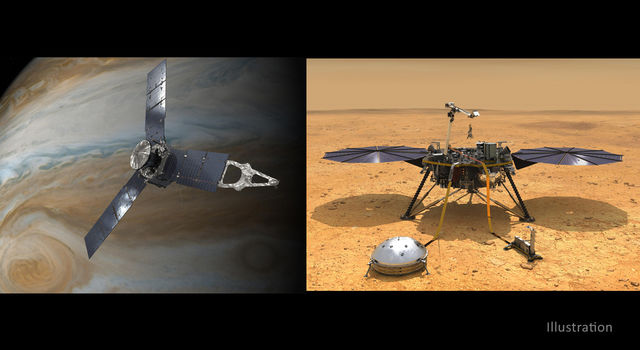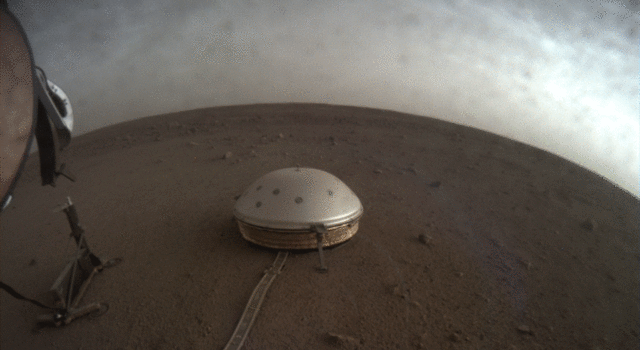Blogs | Dawn Journal | July 5, 2007
July 5, 2007
Dear Countdawns,
The countdown is underway for Dawn’s liftoff on July 8 at 4:04:49 pm EDT.
Launch had been planned for July 7, but unfavorable weather at Cape Canaveral led to the postponement today of the planned liftoff from July 7. The open and close times of Dawn’s daily launch windows for the first few days of its launch period are in a previous log and are transmitted daily in the Telepath Report.
In the last log we followed the plan for what the Delta launch vehicle will do as it delivers its passenger, the Dawn spacecraft, to space. During the 28.5 minutes of their shared flight, the rocket is in control. The timeline is the same for a launch on July 8 as on July 7. For later launches, the coast in Earth orbit will be a little longer, but events before and after will not change.
Following separation, Dawn has three primary objectives: 1) get sunlight on the arrays, 2) establish contact with mission control at JPL, and 3) revel in the beginning of a remarkable mission of exploration. Most of what it does to accomplish the first two steps will be standard procedure for the spacecraft throughout the mission when it encounters a problem and needs to enter “safe mode,” in which it will await instructions from Earth. Of course, separation from the launch vehicle is anything but a problem. Engineers have taken advantage of their extensive work developing the directions Dawn will follow to reach its safe configuration by having it execute nearly the same program as soon as it is flying independently in space. Future logs are sure to have reason to discuss safe mode again.
As few of Dawn’s components as possible are turned on during launch, because with its large solar wings folded against its side (and a segment of the flight in Earth’s shadow), power is provided by a large battery on the spacecraft. Conserving energy (a responsibility familiar to readers on Earth) is vitally important. While on the rocket, Dawn’s computer and a few other devices are operating, heaters are activated as needed, and some data are recorded, but mostly the probe simply waits for the signal that indicates it and the third stage have parted ways.
Because the craft will be returning a tremendous bounty of rich scientific information from distant Vesta and Ceres, its radio system is powerful. Therefore, the transmitter remains off until the solar arrays can provide essentially endless power.
When the third stage releases Dawn, it will leave the spacecraft spinning slowly, with xenon propellant spinning inside in the opposite direction. In addition, the springs that push the spent stage and the eager spacecraft apart are likely to impart a slightly unbalanced push, so Dawn is expected to be turning slowly around all axes. When the computer determines that Dawn has separated, it waits 8 minutes 20 seconds for the friction between the xenon and the spacecraft to lower the spacecraft’s spin rate enough that it can be stabilized by the attitude control system. Known to its friends as ACS, this system is responsible for controlling the spacecraft’s orientation.
After waiting the prescribed time, software directs ACS to begin using its sensors to determine the direction and rate of the spin. Then ACS will command the small rocket thrusters of the reaction control system to fire, gradually stopping the unwanted rotations. The process of bringing the attitude under control can take as little as 1 minute or as long as 15 minutes, depending upon the imbalance in the separation forces and details of the xenon behavior.
Once the spin is fully controlled, it is safe for Dawn to deploy its large solar arrays. Each wing is divided into 5 panels, which are stacked against each other and secured to the spacecraft by cables during launch. To release the wings, small heaters press against the cables, causing them to weaken and break. When they are no longer restrained by the cables, the wings unfold under the gentle urging of springs. With its wings folded, the spacecraft is 1.84 meters (6 feet 1 inch) wide. When they open, the two wings span 19.74 meters (64 feet 9 inches) tip to tip. The software provides 12 minutes 47 seconds to allow the cables to release and the arrays to extend to their full reach.
Although ACS remains in control throughout the solar array deployment, after the computer has allowed for the programmed time to elapse, it requests ACS to perform another stabilization, now with the new, much larger configuration of the spacecraft. ACS may report back that this is complete in as little as 1 minute or as long as 15 minutes.
Just as when a teneral dragonfly spreads wide its new wings for the first time, these intricately patterned marvels must be pointed at the Sun. Up to this time, Dawn has paid attention only to itself, without regard to the external universe. (Of course, it continues coasting away from Earth with the energy given to it by its recent companion, the Delta rocket.) Supported on small extensions from each corner of the boxy body of the spacecraft are solar cells, just like those on the arrays. But these cells are not intended to meet Dawn’s electrical needs; instead, ACS uses them to find the location of the Sun. This is not very different from using your eyes to find the Sun, a particularly appropriate analogy both for dragonflies and for those readers who have eyes that allow them to see in all directions simultaneously. Once it has established where the Sun is, it rotates with its thrusters to point the arrays in that direction. Depending upon the orientation the probe happens to be in prior to this activity, it can take as little as 1 minute and as long as 18 minutes to locate the Sun and complete the turn.
As soon as light from the solar system’s master, the star at the center, reaches the arrays, the battery begins to recharge, and all of Dawn’s electrical needs for the rest of its 8-year mission will be satisfied by the energy the solar cells receive from the Sun.
The computer waits another 4 minutes after the arrays are fully illuminated by the Sun to make sure all systems remain stable, and then it activates its power-hungry radio transmitter. It should take about 4 minutes 30 seconds for the transmitter to warm up and begin sending radio signals, reporting on the status of all systems.
The spacecraft is well prepared to resolve a wide range of problems as it progresses through the list of tasks to complete between separating from the Delta and powering on its radio. If it has not been delayed by correcting any anomalies, the entire sequence could take as little as 32 minutes 37 seconds and as long as 77 minutes 37 seconds; otherwise, this could stretch to over 3 hours. In mission control at JPL, the operations team, taking a cue from one of the virtues Dawn will display as it traverses the solar system, will remain patient. Nevertheless, everyone will look forward to verifying that it is starting its long journey in good health.
But Dawn’s radio signals may not reach Earth quite yet. Without information on where that planet is, the spacecraft cannot know where to point its antenna. (For most of the mission, Dawn will know where it is in relation to Earth and other solar system bodies, but at this early stage, having just begun its flight, such information will not yet be available onboard.)
After it has finished directing its solar arrays at the Sun, the spacecraft begins a roll around the line between it and the Sun, turning once per hour, perhaps appearing like an exotic and lazy windmill. Given the direction of its departure from home, the Sun and Earth will be at about right angles from Dawn’s perspective. So as it makes its slow spin, it uses an antenna pointed at the same right angle to the solar arrays. The antenna sweeps out a broad beam, like a wide searchlight sending its signal out to anyone who happens to see it.
Antennas at the Deep Space Network complex near Canberra, Australia and at the European Space Agency’s facility in Perth, Australia will be ready to detect Dawn’s transmissions and pass the data on to JPL. These stations should be able to receive signals during about half of each rotation of the spacecraft, or about 30 minutes every hour.
It is impossible to predict where Dawn’s antenna will be pointed when it begins transmitting, so it might be aimed at Earth immediately, or it could take as long as 30 minutes until the spacecraft’s rotation brings it around to start the half hour of terrestrial coverage.
With all these steps, the time from liftoff to the receipt of the first radio signal may be as little as about 1 hour 1 minute or as long as 2 hours 16 minutes even if Dawn encounters no surprises along the way, and more than 3 hours 30 minutes if it does. If you are entering your planet’s friendly betting pool on when Dawn’s data first will light up the computers in mission control, you are advised to consider that the likelihood that all circumstances will conspire to yield the shortest possible time is extraordinarily low. That time is more a theoretical minimum than a practical guide, and although mission control will be ready, no one there will be expecting signals that early.
Once controllers see the data, they will begin evaluating the spacecraft’s condition. Over the course of the subsequent few days, they also will review the data it stored during launch and begin configuring it for further operations.
Meanwhile, Dawn will continue racing away from Earth. In less than 2 hours 15 minutes from liftoff, it will be more than 35,800 kilometers (22,200 miles) high, passing the ring of satellites in geosynchronous orbit, and thus will be more remote than the great majority of spacecraft launched in Earth’s half century of probing and utilizing space. It will go beyond the most distant point in the moon’s elliptical orbit less than 29 hours after launch, traveling farther from home than humans have ever ventured. Yet that is but the very beginning of Dawn’s journey.
Distant though it will be, it may be possible for terrestrial observers with capable telescopes to glimpse the probe in the first week or two of its travels. (Other spacecraft have been observed not long after they left Earth. See http://www.jpl.nasa.gov/releases/98/ds1palomar.html for what this former member of the Deep Space 1 team considers to be the best image ever taken of that spacecraft.) It would be very faint, perhaps no more than a speck amidst a sea of stars in the constellation Cetus near right ascension 0 hours 52 minutes and declination -18°. (These approximate coordinates will change by a few degrees if Dawn’s launch does not occur on July 8 at the opening of its window. For a launch at a later time that day, the position will move to slightly higher right ascension. The dependence upon the day in the launch period is more complex, but in general, if the launch takes place on a later day, the location will shift to slightly higher right ascension and higher declination.) For anyone interested in trying to observe the spacecraft, please visit http://ssd.jpl.nasa.gov/horizons.cgi and change the target body to (no surprise here) “Dawn” to find its exact location.
If all goes according to plan, this will be the last log written when Dawn is bound to Earth. We hope readers throughout the cosmos join in wishing the explorer well as it gets underway for a journey that offers new knowledge, excitement, the rewards -- and the risks -- of facing the unknown, and the spirit of adventure that compels humankind to undertake such bold quests.
Dr. Marc D. Rayman
July 5, 2007
TAGS:DAWN, VESTA, CERES, DWARF PLANET, MISSION, SPACECRAFT







